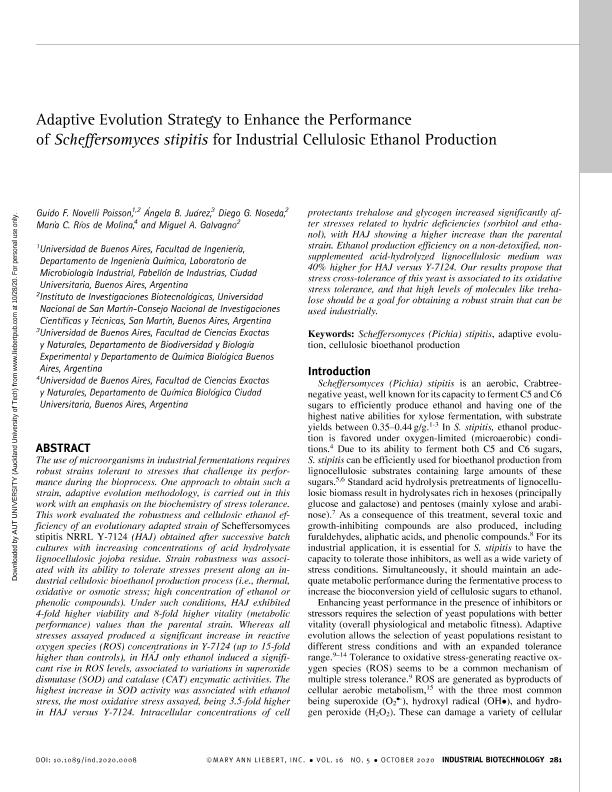Mostrar el registro sencillo del ítem
dc.contributor.author
Novelli Poisson, Guido Fernando

dc.contributor.author
Juárez, Angela Beatriz

dc.contributor.author
Noseda, Diego Gabriel

dc.contributor.author
Ríos de Molina, M.C.
dc.contributor.author
Galvagno, Miguel Angel

dc.date.available
2021-09-17T18:11:02Z
dc.date.issued
2020-10
dc.identifier.citation
Novelli Poisson, Guido Fernando; Juárez, Angela Beatriz; Noseda, Diego Gabriel; Ríos de Molina, M.C.; Galvagno, Miguel Angel; Adaptive evolution strategy to enhance the performance of scheffersomyces stipitis for industrial cellulosic ethanol production; Mary Ann Liebert; Industrial Biotechnology; 16; 5; 10-2020; 281-289
dc.identifier.issn
1550-9087
dc.identifier.uri
http://hdl.handle.net/11336/140750
dc.description.abstract
The use of microorganisms in industrial fermentations requires robust strains tolerant to stresses that challenge its performance during the bioprocess. One approach to obtain such a strain, adaptive evolution methodology, is carried out in this work with an emphasis on the biochemistry of stress tolerance. This work evaluated the robustness and cellulosic ethanol efficiency of an evolutionary adapted strain of Scheffersomyces stipitis NRRL Y-7124 (HAJ) obtained after successive batch cultures with increasing concentrations of acid hydrolysate lignocellulosic jojoba residue. Strain robustness was associated with its ability to tolerate stresses present along an industrial cellulosic bioethanol production process (i.e., thermal, oxidative or osmotic stress; high concentration of ethanol or phenolic compounds). Under such conditions, HAJ exhibited 4-fold higher viability and 8-fold higher vitality (metabolic performance) values than the parental strain. Whereas all stresses assayed produced a significant increase in reactive oxygen species (ROS) concentrations in Y-7124 (up to 15-fold higher than controls), in HÁJ only ethanol induced a significant rise in ROS levels, associated to variations in superoxide dismutase (SOD) and catalase (CAT) enzymatic activities. The highest increase in SOD activity was associated with ethanol stress, the most oxidative stress assayed, being 3.5-fold higher in HAJ versus Y-7124. Intracellular concentrations of cell protectants trehalose and glycogen increased significantly after stresses related to hydric deficiencies (sorbitol and ethanol), with HAJ showing a higher increase than the parental strain. Ethanol production efficiency on a non-detoxified, nonsupplemented acid-hydrolyzed lignocellulosic medium was 40% higher for HAJ versus Y-7124. Our results propose that stress cross-tolerance of this yeast is associated to its oxidative stress tolerance, and that high levels of molecules like trehalose should be a goal for obtaining a robust strain that can be used industrially.
dc.format
application/pdf
dc.language.iso
eng
dc.publisher
Mary Ann Liebert

dc.rights
info:eu-repo/semantics/openAccess
dc.rights.uri
https://creativecommons.org/licenses/by-nc-sa/2.5/ar/
dc.subject
ADAPTIVE EVOLUTION
dc.subject
CELLULOSIC BIOETHANOL PRODUCTION
dc.subject
SCHEFFERSOMYCES (PICHIA) STIPITIS
dc.subject.classification
Otros Tópicos Biológicos

dc.subject.classification
Ciencias Biológicas

dc.subject.classification
CIENCIAS NATURALES Y EXACTAS

dc.title
Adaptive evolution strategy to enhance the performance of scheffersomyces stipitis for industrial cellulosic ethanol production
dc.type
info:eu-repo/semantics/article
dc.type
info:ar-repo/semantics/artículo
dc.type
info:eu-repo/semantics/publishedVersion
dc.date.updated
2021-09-07T15:13:38Z
dc.identifier.eissn
1931-8421
dc.journal.volume
16
dc.journal.number
5
dc.journal.pagination
281-289
dc.journal.pais
Estados Unidos

dc.journal.ciudad
New York
dc.description.fil
Fil: Novelli Poisson, Guido Fernando. Universidad Nacional de San Martín. Instituto de Investigaciones Biotecnológicas. - Consejo Nacional de Investigaciones Científicas y Técnicas. Oficina de Coordinación Administrativa Parque Centenario. Instituto de Investigaciones Biotecnológicas; Argentina
dc.description.fil
Fil: Juárez, Angela Beatriz. Universidad de Buenos Aires. Facultad de Ciencias Exactas y Naturales. Departamento de Biodiversidad y Biología Experimental; Argentina. Consejo Nacional de Investigaciones Científicas y Técnicas; Argentina
dc.description.fil
Fil: Noseda, Diego Gabriel. Universidad Nacional de San Martín. Instituto de Investigaciones Biotecnológicas. - Consejo Nacional de Investigaciones Científicas y Técnicas. Oficina de Coordinación Administrativa Parque Centenario. Instituto de Investigaciones Biotecnológicas; Argentina
dc.description.fil
Fil: Ríos de Molina, M.C.. Universidad de Buenos Aires. Facultad de Ciencias Exactas y Naturales. Departamento de Química Biológica; Argentina
dc.description.fil
Fil: Galvagno, Miguel Angel. Universidad Nacional de San Martín. Instituto de Investigaciones Biotecnológicas. - Consejo Nacional de Investigaciones Científicas y Técnicas. Oficina de Coordinación Administrativa Parque Centenario. Instituto de Investigaciones Biotecnológicas; Argentina
dc.journal.title
Industrial Biotechnology
dc.relation.alternativeid
info:eu-repo/semantics/altIdentifier/doi/http://dx.doi.org/10.1089/ind.2020.0008
Archivos asociados
